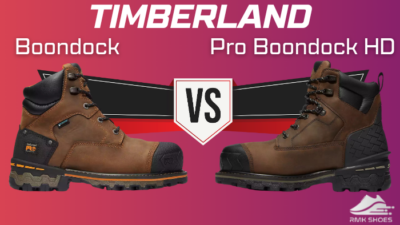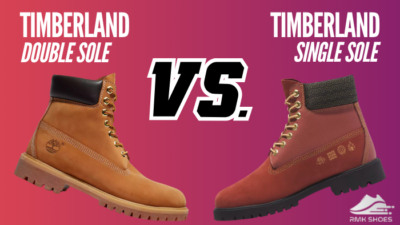Nike has two popular series, Air Zoom Terra Kiger and Pegasus Trail, which are well-known as trail running shoes.
As a trail runner, I bought Terra Kiger 8 and Pegasus Trail 4 last year and spent quality time with those.
I found some differences in performance, traction, fit, etc, between the Nike Air Zoom Terra Kiger 8 and the Nike Pegasus Trail 4. I will discuss those so you can make an informed decision.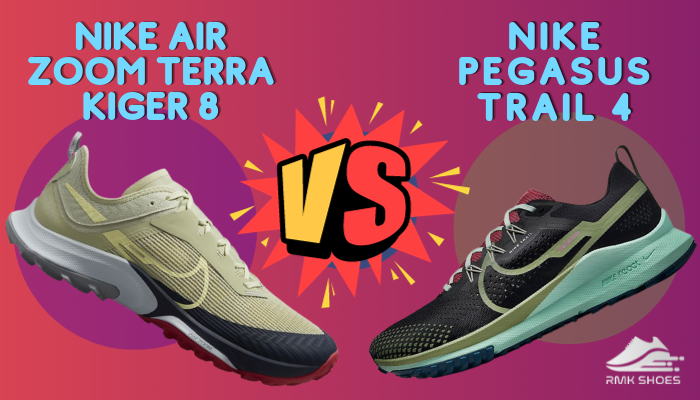
Let’s dive in.
Overview of Nike Air Zoom Terra Kiger 8 and Nike Pegasus Trail 4
After a successful run with the Kiger 7, Nike brought the Air Zoom Terra Kiger 8 in 2022. This trail running shoe is ready to tackle rough terrains with improved features and responsive design.
Kiger 8 comes with an updated breathable mesh upper and modified heel for better foot lockdown compared to its predecessor. The sleek aesthetic makes it a beast trail running shoe.
On the other hand, the Pegasus Trail 4 is the trail version of Nike’s famous road running shoe, Pegasus.
It is more versatile for its balanced cushioning and responsiveness on roads and trails, making it a hybrid choice that appeals to a variety of users.
The excellent grip, versatility, and stability make it a road-to-trail shoe.
With a pocket-friendly price, you will get the supportive and springy React midsole with an improved upper for better lock-in fit.
Attribute Comparison Table: Nike Pegasus Trail 4 vs Nike Air Zoom Terra Kiger 8
Nike Air Zoom Terra Kiger 8 and Pegasus Trail 4 are great for Trail running shoes. So, where do they compare?
The following table highlights the comparison of the Nike Air Zoom Terra Kiger 8 and Pegasus Trail 4. It will shed light on which shoe will ideally suit you.
| Attributes | Nike Air Zoom Terra Kiger 8 | Nike Pegasus Trail 4 |
|---|---|---|
| Upper | Engineered Mesh | Engineered mesh |
| Outsole | Rubber | Rubber |
| Midsole | Nike React, Zoom Air | Nike React |
| Toe box fit | Wide | Normal |
| Stack Height | Forefeet: 30mm/ Heel: 24mm | Forefeet:36mm/ Heel: 26mm |
| Heel-to-Toe Drop | 6mm | 10mm |
| Rock Plate | Yes | No |
| Size | True-to-size | True-to-size |
| Cushioning amount | Litle | High |
| Weight (Approx.) | ~9.9 ounces | ~10.4 ounces |
| MSRP | ~$140 | Same as Kiger 8 |
Now, let’s dive into the detailed comparison.
Key Differences Between Nike Air Zoom Terra Kiger 8 and Nike Pegasus Trail 4
From cushioning to outsole, tongue, upper design, etc, the Nike Air Zoom Terra Kiger 8 and the Nike Pegasus Trail 4 have disparities that can influence your trail running experience.
The different characteristics make them appropriate for specific terrains and running styles. So, learning the comparisons will help you find your suitable foot gear.
Here are the differences between the Nike Air Zoom Terra Kiger 8 and Pegasus Trail 4:
1. Upper Design and Aesthetics
The Terra Kiger 8 features an airy upper. So, breathability is not a concern, and in summer, it remains breezy.
But it has an inner lining that is less airy. The thin mesh upper also has an underside layer to protect from debris.
I noticed the heel counter has a stiff section at the base for lockdown and a softer part near the ankle.
It is a sweet combination of protection and comfort.
Moreover, even though the upper looks plasticky, it appears gorgeous with a trendy color scheme.
But if you don’t like vibrancy, Kiger 8 also offers a black version.
The tongue is made with TPU-like material and is not perforated. The thickness is also good for good midfoot lockdown without noticing the lacing pressure point.
In my test run, the gusseted tongue stayed in the same place. I didn’t experience any heel slippage or discomfort with the Kiger 8.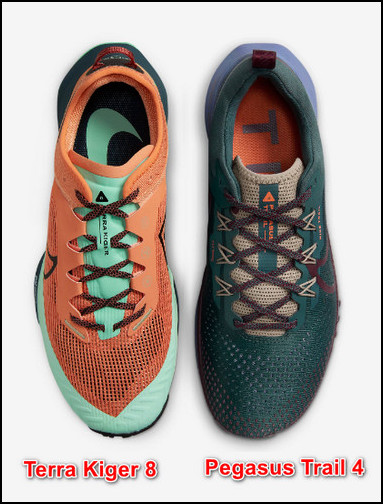
On the contrary, previous Pegasus trail shoes had some issues with the upper. However, Nike improved it in the Pegasus Trail 4 with a light and simple mesh upper.
Due to the amazing breathability, the foot was cool and sweat-free.
The padded and perforated gusseted tongue was also great for secure lacing.
An additional rubber toe cap on the sturdy upper provides protection and durability. The sleek and aesthetic appearance is really appealing as a trail running shoe.
Overall, I liked the Terra Kiger 8 more than the Pegasus Trail 4 regarding the upper.
2. Sole Technology
While Kiger 8 and Pegasus Trail 4 have removable insoles, they have some midsole and outsole dissimilarities.
Midsole
Nike Air Zoom Terra Kiger 8 comes with a stack height of 30mm on the heel and 24mm at the forefeet.
The midsole features a thick React foam layer and an Air Zoom unit at the front. Kiger 8 comes with a rock plate to provide protection without sacrificing flexibility.
The foam’s reactivity was enjoyable at the beginning.
But, after spending around six hours with pronounced forefoot strikes on hard ground, I felt the lugs were kind of poking through the midsole.
However, when I focused on the midfoot, there was no issue at all.
In fact, the React foam showed its charisma with its firmness and reactivity. Additionally, you can also get a ground feel.
Conversely, Pegasus Trail 4 lacks air units and rock plates. The React foam was energetic and soft.
The 36mm forefeet and 26mm heel height provide plenty of cushion. So, the shock protection and rebound were great.
Overall, I enjoyed moving along fast in this shoe.
Outsole
Regarding the outsole, the Terra Kiger 8 has no changes from the Kiger 7 and features the same abrasion-resistant rubber outsole.
Around 3.9 mm lug depth provides excellent traction on various terrains with its aggressive shape.
But as I said earlier, the ride is firmer considering the stack and rock plate. Though it was not a problem for me, you may find it harsh underfoot on hard rocks or roads.
So, it is not a great pick for alternating between trail and road.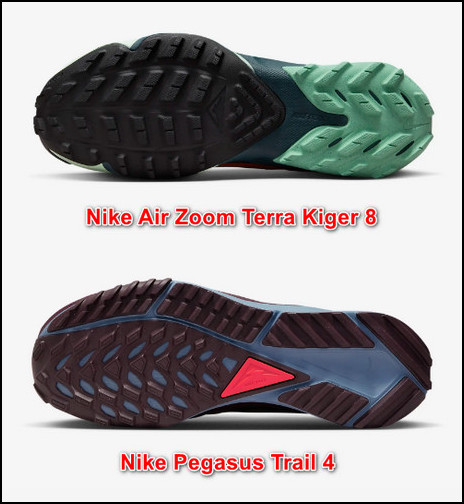
On the other hand, Pegasus Trail 4 features around 3.4 mm lug depth with more likely road shoe treads.
The rubberized outsole had an excellent grip, and it was well-secured & protected on the off-trail, flat, and rolling terrain.
Though, on certain steep rocks, I would say it was subpar.
In addition, one of my friends told me he was not satisfied with the shoe on wet terrain either. He had an uncertain traction feeling.
Overall, it lacks confidence-inspiring for wet rocks to me.
So, when it comes to soles and the trail, Kiger 8 takes the win compared to Pegasus Trail 4.
3. Comfort, Fit and Sizing
With a wide toe box and tight heel fit, the Kiger 8 provided secure foot lock-down.
It took me a longer break-in period compared to other trail shoes. But everything clicked into place after breaking them in.
I didn’t feel any pressure points on the foot. The mesh upper was comfortable and let me push my paces effortlessly.
Though the Kiger 8 is true to size, I found it to run long and recommend going for half size down for a more snug fit.
In contrast, Pegasus Trail 4 has a regular toe box and heel fit.
You may know that Nike shoes are so narrow. Despite having a reputation for fitting narrow, Nike Trail 4 can accommodate wide feet.
Though it’s not the best for wider feet, the roomy and rounded toe box makes it suitable for most.
The heel cup was firm and sat high on the ankle as a sibling to the Pegasus road shoe line.
The shoe was not too tight and had wiggle room. So, it’s true to size for me, but one of my running partners mentioned that the Kiger 8 felt tight for him. He recommended that I consider sizing up.
Depending on your use, you can go either way.
Overall, both shoes take the win when it comes to comfort and fit.
4. Cushioning and Stability
Nike tried to improve the Terra Kiger over the years, and the Kiger 8 received various improvements.
To make it more stable and comfortable, Nike builds the Kiger 8 with a high stack height and a 6mm heel-to-toe drop to make it more stable and comfortable.
On top of that, the React foam provides stability, and the Zoom Air unit softens the shoe slightly to make it comfortable.
It’s a perfect blend for a responsive ride.
The redesigned heel helps prevent slips, and the rock plate in Kiger 8 is also better at shock absorbing while protecting from sharp rocks.
In contrast, from the running experience, the full-length React foam in the midsole of the Pegasus Trail 4 was pleasant and flexible.
I also noticed the cushioning was light and responsive.
The 10mm drop is higher than the Kiger 8 and is slightly higher for a trail shoe. But I didn’t find it unstable.
One feature that sets back the Trail 4 from the Kiger 8 is the lack of a rock plate. Other than that, it was soft and flexible on trails and roads.
Due to having the rock plate, I prefer the Nike Kiger 8 when there are sharp rocks. But other than that, they are a tie.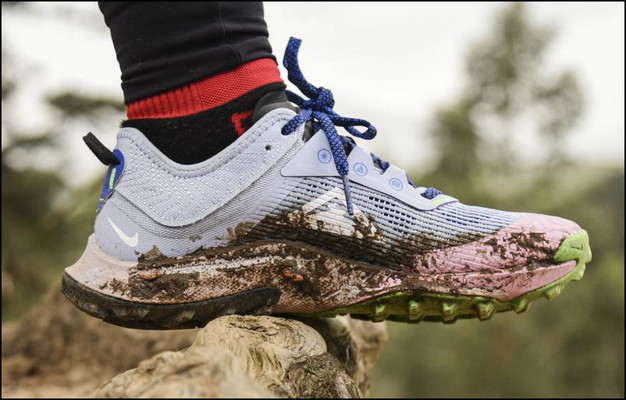
5. Performance and Durability
Both trail shoes are great for performance on different terrain.
Performance
Nike Terra Kiger 8, with its responsive cushioning and aggressive outsole, provides excellent performance.
The shoe will offer a good energy return if you go fast on trails. Due to the shoe design, it is best to use it for short and medium runs. Thanks to its precise foot lockdown and lightweight.
In terms of weight, the shoe is approximately 9.9 oz.
Conversely, due to the lug pattern, the Nike Pegasus Trail 4 offers a smooth ride on moderate or light trails.
The springy ride React foam delivers, ensuring an effortless transition between road and trail running.
Whether short sprints to long-distance or recovery runs, Trail 4 provides comfort and security with its Flywire laces.
However, quick movement can cause some discomfort. Moreover, it is also slightly heavier than the Kiger 8.
Durability
The Nike Air Zoom Terra Kiger 8 has a slight edge when it comes to durability. The construction and rugged design can protect the shoe from wear and tear.
I have used the shoe for over 80+ miles, and it still holds up. The 2mm outsole is still great.
If you can take care of it and run through easy trails, it shouldn’t show any signs of wear for extended periods.
Similar to the Kiger 8, the Pegasus Trail 4 also holds up well over time. Its high-quality materials barely show wear and tear signs even after a 60+ mile ride.
Though the 1.4 mm outsole is thin, the tread shows minimal signs of wearing.
However, the lug’s durability can become a concern if you primarily use it on roads.
The shoe doesn’t gather that much dirt and dust. Even if it accumulates, you can easily clean it and ready the shoe for the long run.
The rugged design of Kiger 8 and the sturdy construction of Pegasus Trail 4 make it a tie when it comes to performance and durability.
6. Price and Value
Regarding the price, the Air Zoom Terra Kiger 8 and Pegasus Trail 4 come at a reasonable rate.
Both trail running shoes cost around $140.
And when it comes to value, both the Pegasus Trail 4 and Terra Kiger 8 deliver a solid bang for the buck.
The durable construction and versatile features they offer at such an excellent price are totally worth it.
So, both take the win.
Pros & Cons of Nike Air Zoom Terra Kiger 8 and Nike Pegasus Trail 4
The Nike Air Zoom Terra Kiger 8 and the Pegasus Trail 4 offer distinct features that can influence your trail running experience.
The advantages and drawbacks each trail running shoe brings to the table can help you make an informed decision.
Here are the pros and cons of the Nike Air Zoom Terra Kiger 8 and Pegasus Trail 4:
Nike Air Zoom Terra Kiger 8
- »Lighter than Pegasus Trail 4.
- »Stylish appearance.
- »Long-lasting durability.
- »Effective shielding against rocks.
- »Responsive and energetic performance.
- »Excellent foot lockdown.
- »Outstanding heel grip.
- »Great breathability.
- »Reliable traction for a smooth ride.
- »Unsuitable for technical terrains.
- »Firm cushioning.
- »Wet surface performance is not great.
- »Potential discomfort on hard surfaces.
Nike Pegasus Trail 4
- »Lighter than its predecessor.
- »Notably durable and well-cushioned.
- »Versatile for various trail terrains.
- »Comfortable and secure fit with Flywire lacing system.
- »Appealing design with a breathable mesh upper.
- »Outstanding traction ensures a stable ride.
- »Heavier than Terra Kiger 8.
- »Subpar traction on slippery or rocky surfaces.
- »Unsuitable for wide feet due to narrow toe box.
- »Excessive stack height.
Which to Choose: Nike Air Zoom Terra Kiger 8 or Nike Pegasus Trail 4?
The competition between the Nike Pegasus Trail 4 and Air Zoom Terra Kiger 8 is tight.
The Kiger 8 offers a lightweight design, responsive cushioning, and superior traction on the trail compared to Trail 4.
On the contrary, Pegasus Trail 4 shows agility, comfort, and flexibility on roads and trails.
So, the running style, fit, terrain, etc, impacts the running experience and your go-to choice.
For a dedicated trail running shoe, I prefer the Terra Kiger 8 for its rock plate, upper, midsole, and outsole.
But if you intend to use it both on the road and trail, Pegasus Trail 4 is an excellent choice in that case.
FAQs
How do the Nike Pegasus Trail 4 and Kiger 8 fit?
Pegasus Trail 4 usually fits true to size. Though it has more wiggle room than other Nike shoes, it’s not best for wide feet. The Nike Kiger 8 is also true to size but recommended to buy a half size down. For wider feet, true to size will do the work.
Should you wear the Nike Terra Kiger 8 and Pegasus Trail 4 for hiking?
Due to lightweight trail shoes, the Terra Kiger 8 is perfect when used on trails. However, due to the cushioning and outsole, it’s not best for backpacking and hiking. Being a hybrid one, you can use the Pegasus Trail 4 for hiking.
Should you race with Nike Pegasus Trail 4 or Kiger 8?
It’s not ideal and comfortable to race with the Nike Pegasus Trail 4 and Kiger 8 for their design and construction. The lugs are suitable for trails but will lose your efficiency when racing.

